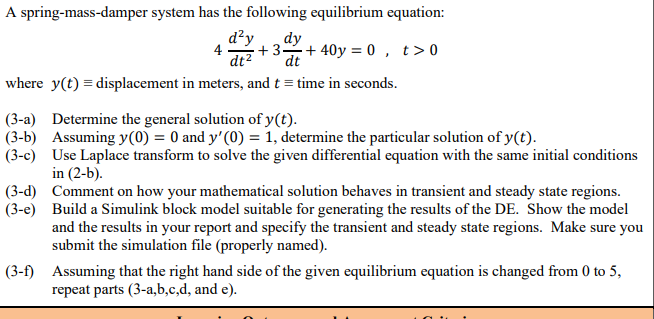(3-c) Use Laplace transform to solve the given differential equation with the same initial conditions in (2-b).
(3-c) Use Laplace transform to solve the given differential equation with the same initial conditions in (2-b).
Advanced Engineering Mathematics
10th Edition
ISBN:9780470458365
Author:Erwin Kreyszig
Publisher:Erwin Kreyszig
Chapter2: Second-order Linear Odes
Section: Chapter Questions
Problem 1RQ
Related questions
Question
Part c please

Transcribed Image Text:A spring-mass-damper system has the following equilibrium equation:
d²y
dy
+3+ 40y = 0 , t>0
dt²
dt
where y(t) = displacement in meters, and t = time in seconds.
(3-a) Determine the general solution of y(t).
(3-b) Assuming y(0) = 0 and y'(0) = 1, determine the particular solution of y(t).
(3-c) Use Laplace transform to solve the given differential equation with the same initial conditions
in (2-b).
(3-d) Comment on how your mathematical solution behaves in transient and steady state regions.
(3-e) Build a Simulink block model suitable for generating the results of the DE. Show the model
and the results in your report and specify the transient and steady state regions. Make sure you
submit the simulation file (properly named).
(3-f) Assuming that the right hand side of the given equilibrium equation is changed from 0 to 5,
repeat parts (3-a,b,c,d, and e).
Expert Solution
This question has been solved!
Explore an expertly crafted, step-by-step solution for a thorough understanding of key concepts.
Step by step
Solved in 2 steps with 4 images

Knowledge Booster
Learn more about
Need a deep-dive on the concept behind this application? Look no further. Learn more about this topic, advanced-math and related others by exploring similar questions and additional content below.Recommended textbooks for you

Advanced Engineering Mathematics
Advanced Math
ISBN:
9780470458365
Author:
Erwin Kreyszig
Publisher:
Wiley, John & Sons, Incorporated

Numerical Methods for Engineers
Advanced Math
ISBN:
9780073397924
Author:
Steven C. Chapra Dr., Raymond P. Canale
Publisher:
McGraw-Hill Education

Introductory Mathematics for Engineering Applicat…
Advanced Math
ISBN:
9781118141809
Author:
Nathan Klingbeil
Publisher:
WILEY

Advanced Engineering Mathematics
Advanced Math
ISBN:
9780470458365
Author:
Erwin Kreyszig
Publisher:
Wiley, John & Sons, Incorporated

Numerical Methods for Engineers
Advanced Math
ISBN:
9780073397924
Author:
Steven C. Chapra Dr., Raymond P. Canale
Publisher:
McGraw-Hill Education

Introductory Mathematics for Engineering Applicat…
Advanced Math
ISBN:
9781118141809
Author:
Nathan Klingbeil
Publisher:
WILEY

Mathematics For Machine Technology
Advanced Math
ISBN:
9781337798310
Author:
Peterson, John.
Publisher:
Cengage Learning,

